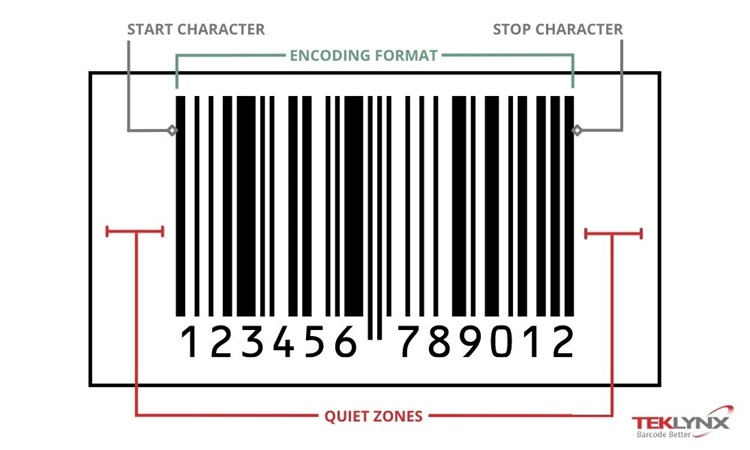โปรดเลือกตำแหน่งที่ตั้งและภาษาของคุณเพื่อรับประสบการณ์เว็บไซต์ที่ดีที่สุด

In today's fast-paced and interconnected world, the ability to efficiently track and manage products is crucial for businesses of all sizes. This is where barcodes come into play. Barcodes are not just simple lines and numbers; they are powerful tools that facilitate seamless inventory management, enhance supply chain operations, and enable businesses to operate with remarkable efficiency.
In this blog post, we will delve into the technicality behind barcodes, explore different types of barcodes, explain how barcodes work, discuss their diverse applications, and highlight why they are indispensable to the supply chain and businesses.
Before getting into how barcodes work, it’s important to understand the technicality of a barcode. At the core of every barcode lies a system of encoded data that can represent various types of information, such as product numbers, prices, batch codes, or serial numbers. The encoding format, or symbology, determines how the data is represented in the barcode, and each symbology has its own rules and structure for encoding alphanumeric characters and special characters.
Barcodes typically begin and end with special characters known as start and stop characters. These characters indicate the beginning and end of the barcode and help scanners recognize the barcode's boundaries. The lines or dots in a barcode form a unique pattern that corresponds to the encoded information. When scanned, a barcode reader or scanner detects and interprets these patterns to extract the encoded data.
Quiet zones, blank areas on both sides of the barcode, provide a clear space surrounding the barcode lines or dots. These zones ensure that no other elements interfere with the scanning process, serving as a reference point for the beginning and end of the barcode.

There are many different types of barcodes, each with its own purpose. Some of the most common types of barcodes include:
Barcodes can be printed on various surfaces, such as product labels or packaging, using the appropriate printing technology, ink contrast, label material, and size. Scanners, equipped with optical technology, emit light onto a barcode and analyze the variations in light reflection caused by differences in line thickness and spacing. This allows the scanner to interpret the barcode's pattern and decode the encoded data.
Once the scanner captures the reflected light, it converts the information into an electrical signal. The scanner then decodes the encoded data based on the specific symbology used, passing it to connected systems for further processing. The decoded data seamlessly integrates into various business systems, enabling real-time updates, automated processes, and accurate tracking throughout the supply chain.
In other words, a barcode is simply a method of encoding information into a visual pattern a scanner can read; black lines absorb light while the white area reflects light, and the amount of light reflected is converted to data a computer can understand.
Barcodes revolutionize the way businesses operate and manage their supply chains. Here are a few key reasons why they are vital:
When it comes to barcode generation software, TEKLYNX stands out as a leading solution provider with a reputation for excellence. Here are several reasons why TEKLYNX is considered the best software for generating barcodes:
TEKLYNX has developed over 4,000 native label printer drivers to enable seamless label printing. Our development teams across the globe work closely with printer manufacturers such as Zebra, Epson, Brother, BIXOLON, TSC, VIPColor, and more to develop high quality drivers that optimize printer performance.
TEKLYNX software provides an extensive range of symbologies, including UPC, EAN, Code 39, Code 128, QR codes, and more. The software also supports various label design capabilities, such as text and image formatting, database integration, and automation workflows.
With intuitive design and navigation, users can quickly and easily create, customize, and print barcodes. The software offers a visual label design editor, drag-and-drop functionality, and wizards that simplify the barcode generation process.
By using TEKLYNX software, businesses can generate barcodes that meet industry requirements, guaranteeing compatibility and interoperability across different systems and organizations.
TEKLYNX software seamlessly integrates with other business systems, such as enterprise resource planning (ERP) software or warehouse management systems (WMS). TEKLYNX software can also integrate with spreadsheets, databases, and data stored in the cloud.
TEKLYNX offers scalable solutions that cater to businesses of all sizes, from small enterprises to large corporations. Whether a business requires a single workstation or a multi-user network environment, TEKLYNX software provides flexible licensing options to accommodate evolving needs and can grow with businesses as their labeling needs grow.
Our customer support team is readily available to address any questions or concerns, ensuring a smooth experience with the software. TEKLYNX offers live monthly training webinars and has a library of resources available at your fingertips.
TEKLYNX software stands out as the best solution for generating barcodes. By choosing TEKLYNX, businesses can harness the power of barcodes, streamline their operations, improve efficiency, and achieve greater success in today's competitive business landscape.
Request a consult to see which barcode labeling software is right for you, or download a free 30-day trial of CODESOFT to start generating your own barcodes.
Ready to buy CODESOFT and start generating barcodes today? You can buy it online and have your license within 30 minutes.
Nick Recht is the Sales Manager for the Americas region at TEKLYNX RFID and barcode label solution provider. He leverages his passion for using technology to add value to businesses and his 15 years of AIDC experience to help organizations of all sizes barcode better. When he is not working, he is driving one of his daughters to a practice of some sort or doing a project around the house.
There is a common misconception that creating and leveraging barcodes is an expensive or time-consuming investment when in reality there are barcode label software solutions with low up-front costs that are easy to install and use, plus pave the way for scalability as your company grows.
READ MORE
Merriam Webster says a barcode is “a code consisting of a group of printed and variously patterned bars and spaces and sometimes numerals that is designed to be scanned and read into computer memory and that contains information about the object it labels.” While it’s great to know the technical definition of the word, what does that mean for you and your business?
READ MORE
Barcode symbologies differ by the type of data they hold and are encoded with. In this blog, we go over the categories of barcodes, the most common types of barcodes, and how to choose the best one for your labels.
READ MORE© Copyright 2025 TEKLYNX CORPORATION SAS. สงวนลิขสิทธิ์
What do you think? Leave us a comment.
Comments will be reviewed and are subject to TEKLYNX’ comment policy. Your email address will not be published publicly.